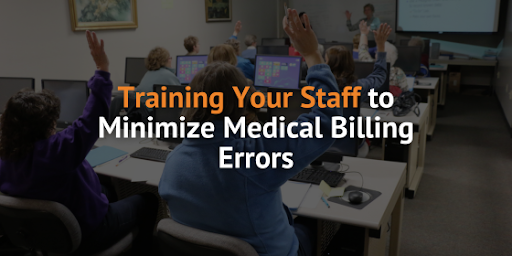Medical billing errors are a significant cause of revenue loss and delayed payments in healthcare practices. In fact, this can translate into 3-5% revenue loss. These errors can range from simple coding mistakes to more complex issues like inaccurate patient information.
This cannot underscore enough the value in properly training your staff to minimize these errors and improve overall revenue cycle management.
Here are several strategies to help reduce billing mistakes.
1. Comprehensive Training on Medical Coding
Coding errors are among the most common reasons for claim denials. Ensure that your staff is thoroughly trained in the latest coding standards, such as ICD-10 and CPT. This not only requires initial instruction but also ongoing education to keep up with frequent changes in coding guidelines. Medical billing software that provides real-time feedback within its billing system can help your staff catch coding errors before claims are submitted, reducing the time spent on corrections and resubmissions, thereby improving claim acceptance rates.
2. Prioritize Accurate Data Entry
Inaccurate patient information—such as misspelled names, incorrect insurance details, or missing policy numbers—can delay payments and result in claim denials. To address this, practices should establish a clear protocol for verifying and entering data. Training your staff to double-check their entries can drastically reduce these common but costly errors. Make this easier on staff by utilizing medical billing software with built-in data verification tools. Simplify this process by automating many aspects of data entry, ensuring accuracy from the start and allowing staff to focus on more nuanced tasks.
3. Leverage Automation for Routine Tasks
Manually handling repetitive tasks, such as checking insurance eligibility or processing claims, is time-consuming and increases the likelihood of errors. By adopting billing software that automates these functions with eligibility checks and electronic claim submissions, practices can reduce the administrative load and improve billing accuracy. Automation ensures these tasks are completed consistently and with fewer mistakes.
4. Regular Audits and Continuous Feedback
Even with automation and thorough training, mistakes can happen. Conducting regular audits of billing practices will help identify areas where staff might need further training. Providing ongoing feedback allows your team to improve their skills and stay on top of best practices. Support your practice with robust reporting capabilities that make it easy to monitor billing trends and catch errors early. These reports give you the insights needed to fine-tune operations and offer targeted feedback to your billing team.
5. Stay Updated on Industry Changes
The world of medical billing is constantly evolving, with new regulations and requirements emerging frequently. Keeping your team informed about these changes is crucial to maintaining compliance and minimizing errors. Regular training sessions or industry webinars can be valuable tools for staying up to date.
Find the Perfect Medical Billing Software for Your Practice
Training your staff to minimize medical billing errors is not just about one-time education—it’s an ongoing process of updating skills, leveraging technology, and continuous improvement. Tools like EZClaim can play a crucial role in supporting these efforts by automating routine tasks, enhancing accuracy, and providing actionable insights. To see how EZClaim can reduce billing errors in your practice, consider scheduling a demo today. Book a free demo today!


